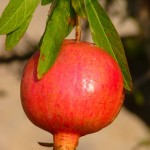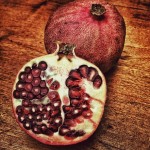
Unlike popular belief, pomegranate fruit is a berry, despite its leather-like skin and the hundreds of seeds inside. Each and every seed is contained in a scarlet colored, juicy aril. These arils are the only edible part of the fruit. They taste sour and sweet at the same time. With its high nutrition content, you will have no regrets in knowing about this fruit.
Like other berries, pomegranates are very rich in dietary fiber. However, it is all contained in the seed inside the arils, so don’t throw away the seeds when you consume the arils. Every fruit contains around 840 arils. They also contain high levels of potassium, Vitamin C, and antioxidant, while being low in calories. When dried, these nutritious contents are naturally concentrated, raising it even more. Despite its arils are usually red or purple, when dried they can be pink or red, but usually white.
Scientifically, pomegranates are called ‘punica granatum’, or literally an apple of seeds. Native to the area of modern day Iran and Iraq, the pomegranate has been cultivated in the Caucasus since ancient times. From there, it spread to Asian areas such as the Caucasus as well as the Himalayas in Northern India.
In many civilizations, such as Ancient Egypt and China, the pomegranate is a widely known symbol of fertility, with its hundreds of seeds. Regarded as the oldest known fruit consumed by mankind, the fruit and its benefits have made their way into the stories and mythos of many cultures. So much so that scholars debate whether it was a pomegranate, instead of an apple, that caused Adam and Eve to be banned from the Garden of Eden.
Pomegranate juice is notable in its ability to fight tooth decay, as well as keeping the gums healthy. Dried pomegranate is also used as an ingredient of many medicinal drugs that can be used to cure weak eye sight, allergies, diarrhea, worms, hemorrhoids, dysentery, etc.
Explore Articles
 Dried pomegranates – The Marvel Fruit
Dried pomegranates – The Marvel FruitDried pomegranates are good for your health. While pomegranates are commonly red, when dried it can be in many colors, including pink and red,...
 Benefits Of Dried Pomegranates For Your Heart
Benefits Of Dried Pomegranates For Your HeartSeveral studies have suggested that dried pomegranates are healthy for your heart. Daily consumption of the dried fruit can help in normalizing your blood...
 The Nutritional Contents of Dried Pomegranate
The Nutritional Contents of Dried PomegranatePomegranate is native to the region now known as Iran and Iraq. It has been cultivated since ancient times, finding its way into our...
 Is Dried Pomegranate Beneficial For Osteoarthritis?
Is Dried Pomegranate Beneficial For Osteoarthritis?Dried pomegranate is considered to help minimize the risk of developing osteoarthritis and atherosclerosis. Research studies have found that the fruit works by preventing...
